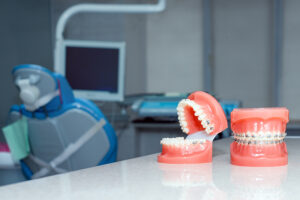A confident smile can change the way you feel about yourself and how others perceive you, but achieving that perfect smile often involves a journey—and it starts with choosing the right one from the different types of dental braces. Whether you’re dealing with crooked teeth, a misaligned bite, or gaps that you’d like to close, braces are the go-to solution for many seeking a healthier, more beautiful smile.
But here’s the twist: Not all braces are created equal. From barely noticeable clear aligners to traditional metal braces that have stood the test of time, the choices can feel overwhelming. So, how do you know which type will best suit your needs, your lifestyle, and your budget?
Overview of Dental Braces
Dental braces are an essential tool in orthodontics, designed to correct misalignments of the teeth and jaw. They work by gradually applying pressure to the teeth, moving them into a more aligned position over time. While braces are commonly associated with improving the appearance of a smile, they also contribute significantly to better oral health by making it easier to clean your teeth, preventing issues like tooth decay, gum disease, and even jaw pain.
Braces are made up of several key components that work together to shift the teeth:
- Brackets: These small squares are attached to each tooth. They act as handles for the archwire to move the teeth.
- Archwire: This is the thin metal wire that connects all the brackets. The archwire is periodically tightened to apply pressure to the teeth and move them into place.
- Bands: These are small rings placed around the back teeth to hold the braces in place. They also help anchor the archwire.
- Ligatures: These are small elastic bands or wires that attach to the brackets, holding the archwire in place.
The Purpose of Braces
The primary purpose of braces is to correct problems related to the alignment of the teeth and jaw, known as malocclusions. These issues can include:
- Crooked or crowded teeth: Teeth that overlap or twist, making it harder to maintain oral hygiene.
- Overbite or underbite: Where the upper or lower teeth extend too far out of alignment with the opposing teeth.
- Gap teeth: Spaces between teeth that can lead to discomfort and difficulty with eating.
- Open bite: When the front teeth do not come together properly, affecting chewing and speaking.
Different Types of Dental Braces
When it comes to choosing braces, there’s no one-size-fits-all solution. The type of braces you select will depend on various factors like the severity of your dental issue, your aesthetic preferences, budget, and treatment time.
Traditional Metal Braces
Traditional metal braces are the most common and well-known type of braces. They consist of stainless steel brackets that are bonded to your teeth and connected by an archwire. Small elastic bands (ligatures) are used to secure the archwire to the brackets.
Pros:
- Highly effective: Metal braces are perfect for treating a wide range of orthodontic issues, from simple to complex alignment problems.
- Durable: They are strong and less likely to break or come off compared to other different types of dental braces.
- Affordable: Metal braces are generally the most cost-effective option, making them a great choice for those on a budget.
Cons:
- Noticeable: Metal braces are the most visible type, which may be a concern for people who are conscious about their appearance, especially adults.
- More frequent adjustments: You’ll need to visit your orthodontist regularly to have your braces tightened and adjusted, which can be time-consuming.
Ceramic Braces
Ceramic braces are similar to metal braces in design, but instead of metal, they use clear or tooth-colored ceramic brackets. These braces are often preferred for their ability to blend in with the natural color of the teeth.
Pros:
- Less noticeable: The clear or tooth-colored brackets are much less conspicuous than metal braces, making them a popular choice among teens and adults who are looking for a more aesthetic option.
- Effective: Like metal braces, ceramic braces are highly effective in treating complex orthodontic issues.
Cons:
- Fragile: Ceramic brackets are more likely to break or chip compared to metal braces, especially if they’re exposed to excessive force.
- Prone to staining: The elastics used in ceramic braces can stain, so you may need to replace them frequently and be mindful of what you eat and drink.
- Cost: Ceramic braces are generally more expensive than metal braces due to the materials and the extra care needed to maintain them.
Lingual Braces
Lingual braces are unique in that they are placed on the back (lingual) side of the teeth, making them invisible when you smile. These braces are custom-made to fit the contours of your teeth, making them a discreet and effective option.
Pros:
- Invisible: Because lingual braces are attached to the back of your teeth, they are the most discreet option available.
- Custom fit: Lingual braces are tailored to the individual shape of your teeth, which can offer a more personalized treatment experience.
Cons:
- Discomfort: Lingual braces can be more uncomfortable than other types because they are placed on the tongue side of the teeth, which can make speaking and eating more difficult at first.
- Difficult to clean: Cleaning lingual braces can be challenging due to their placement, making it important to maintain excellent oral hygiene.
- Cost: Lingual braces tend to be more expensive than metal and ceramic braces due to the customization required and the complexity of the treatment.
Clear Aligners (e.g., Invisalign)
Clear aligners, such as Invisalign, are a modern alternative to traditional braces. These custom-made, transparent plastic trays fit over your teeth and gradually shift them into place. They are removable, which makes them a convenient option for people who want flexibility in their orthodontic treatment.
Pros:
- Invisible: The clear plastic trays are nearly invisible, making them a great choice for those who don’t want others to know they’re wearing braces.
- Comfortable: Clear aligners are made from smooth plastic, meaning there are no metal brackets or wires to irritate the inside of your mouth.
- Removable: You can remove the aligners when eating or drinking, which makes it easier to maintain good oral hygiene. Plus, there are no dietary restrictions.
Cons:
- Not suitable for complex cases: While clear aligners are great for minor to moderate alignment issues, they may not be effective for more severe dental problems.
- Discipline required: Since aligners are removable, you must wear them for 20–22 hours a day for the treatment to be effective. Failure to wear them as instructed can slow down your progress.
- Cost: Clear aligners are often more expensive than traditional braces, and the price can vary depending on the length of treatment.
Factors to Consider When Choosing Among the Different Types of Dental Braces
Selecting the right one among different types of dental braces goes beyond just aesthetics—it’s about finding the best solution for your dental needs, lifestyle, and budget. Here are the key factors to keep in mind:
1. Severity of the Orthodontic Issue
- Mild to Moderate Issues: Clear aligners like Invisalign are great for less complex cases, such as small gaps or slightly crooked teeth.
- Severe Misalignment: Metal or ceramic braces are better for complex issues like overbites or severely crooked teeth.
2. Budget and Costs
- Metal Braces: Most affordable, ranging from $3,000 to $7,000.
- Ceramic Braces: More expensive, typically $4,000 to $8,000.
- Lingual Braces: Custom and costly, ranging from $8,000 to $10,000.
- Clear Aligners: Similar in cost to ceramic braces, $4,000 to $7,000.
Remember to account for follow-up visits, adjustments, and retainers in the total cost.
3. Aesthetic Concerns
- Clear Aligners and Ceramic Braces: Less visible, ideal for those who want a discreet treatment.
- Lingual Braces: Invisible from the front but more expensive and harder to clean.
4. Treatment Duration
- Clear Aligners: Typically 12-18 months for mild to moderate cases.
- Braces: Traditional braces can take 18 months to 3 years, depending on severity.
5. Comfort and Maintenance
- Clear Aligners: The most comfortable and easy to maintain, as they’re removable.
- Braces: Traditional metal and ceramic braces may cause discomfort and require more upkeep. Lingual braces can irritate the tongue and are harder to clean.
Take the First Step Toward a Beautiful Smile Today!
At Advanced Emerald Dentistry, we believe everyone deserves a healthy, confident smile. Whether you’re considering braces or need general dental care, our expert team in Pierce County is here to guide you every step of the way. We offer personalized treatments to ensure you receive the best care, from routine check-ups to advanced orthodontic options.
Don’t wait to get the smile you’ve always wanted! Contact us today to schedule an appointment at our Puyallup or Graham locations, and discover how we can help you achieve a healthier, more beautiful smile. Let Advanced Emerald Dentistry be your trusted partner in dental health!



